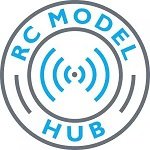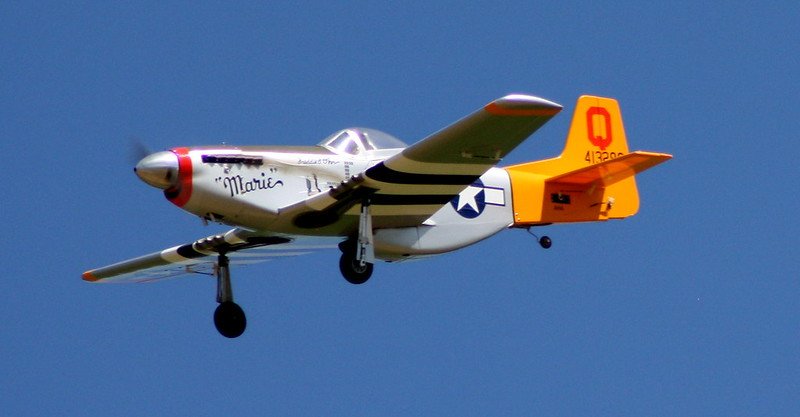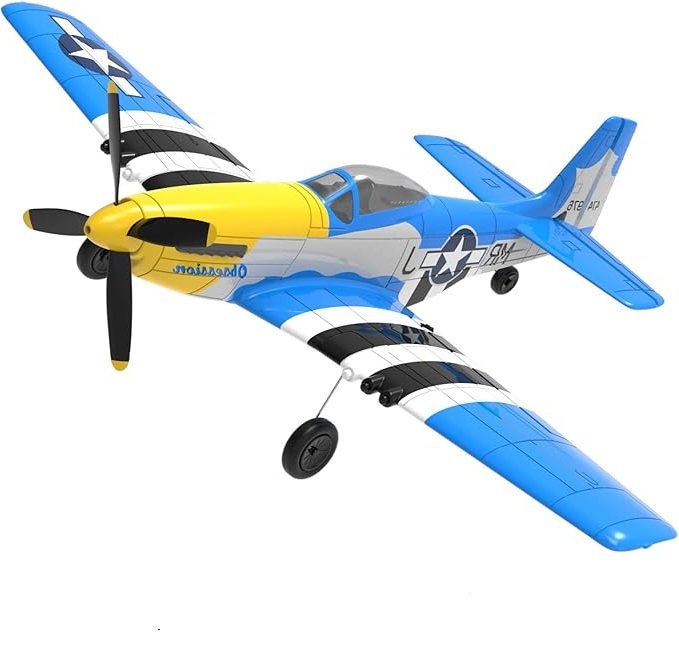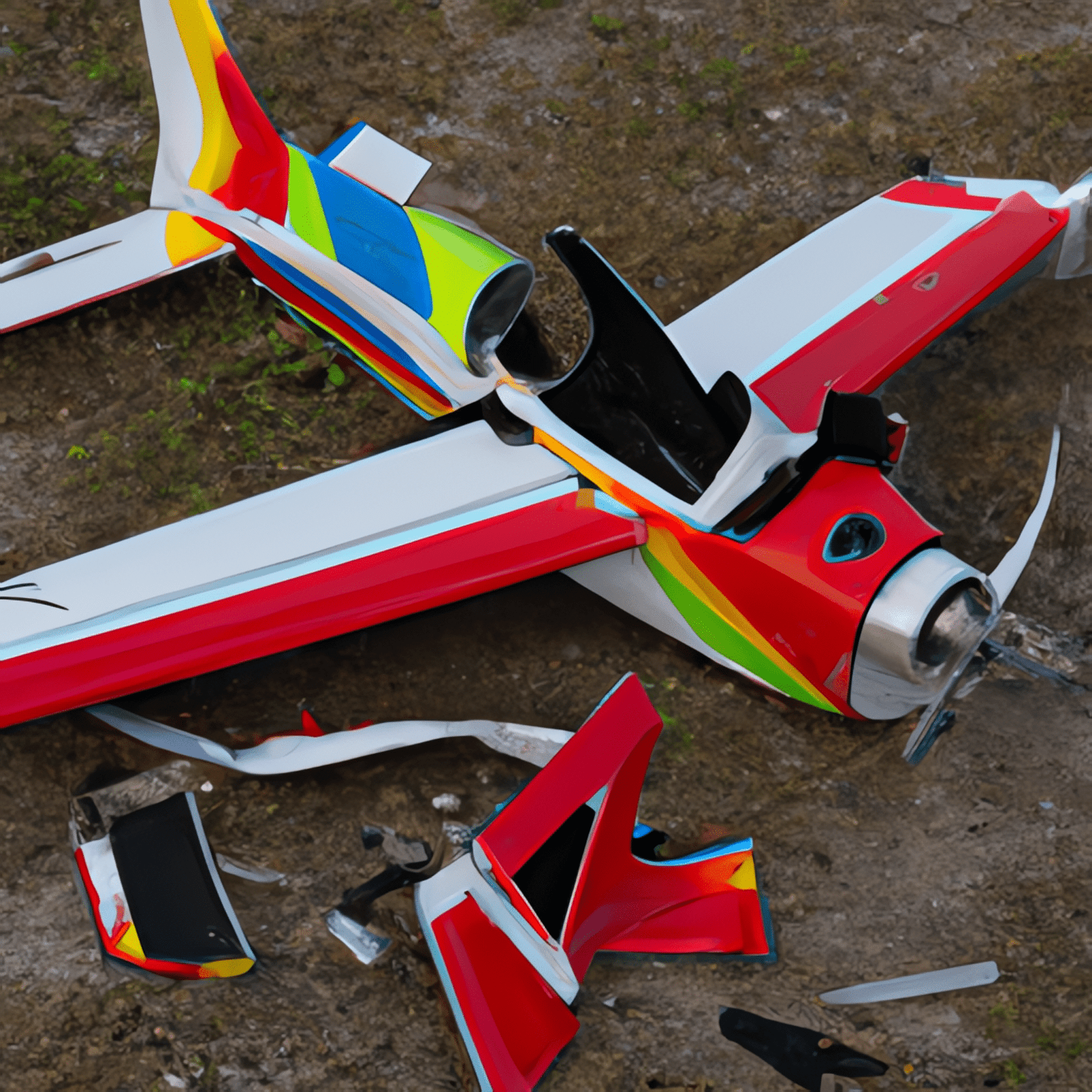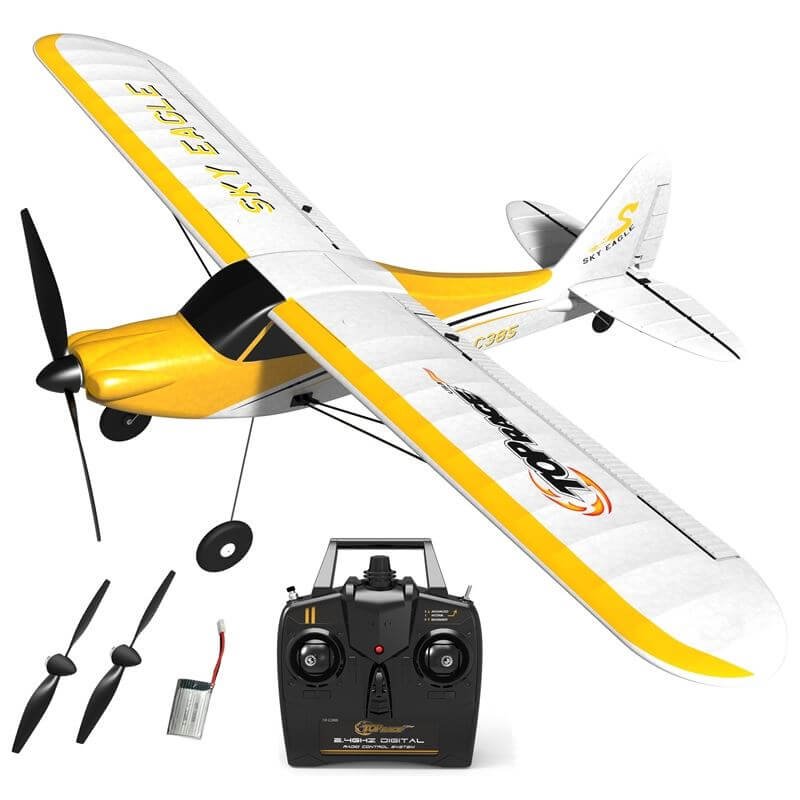Ever wondered what RC airplanes were made of? We take a closer look at foam RC planes for beginners – the most common material used for radio control model planes today – and let you know everything you really need to know as a beginner to the hobby.
- What Is a Foam RC Plane?
- Advantages of a Foam RC Plane
- Disadvantages of a Foam RC Plane for Beginners
- What are the alternatives to foam in RC planes?
- Types of Foam for RC Planes
- Beginners’ Foam RC Planes
- Foam RC plane Kits
- Frequently Asked Questions
- What is a foamie RC plane?
- What is a 3d foam RC plane?
- What is the difference between EPO and EPP foam?
- Which foam is best for RC planes?
- What’s the best type of Foam Glue for RC Planes?
- Is Gorilla Glue good for foam airplanes?
- What’s the best paint for my foam RC plane?
- How do you fix foam RC plane wings?
- How do you fix crushed foam?
- Can I make large foam RC planes?
- Conclusion
What Is a Foam RC Plane?
Foam RC planes – or “foamies” – are great beginner’s airplanes because they’re inexpensive, lightweight, durable, and easy to fly. They come in many shapes and sizes and are perfect for kids and adults alike.
They’re also very robust. Unlike traditional model airplanes, foam RC planes aren’t made out of fragile materials like balsa wood. Instead, they’re constructed out of tough plastic foam that would survive a rough landing or in many cases, worse, with minimal damage.
They’re also great for beginners because they’re simple to build and control. And they’re perfect for anyone who wants to learn how to fly a plane.
Foam RC planes also come in a variety of different models, including propeller-driven, jets, gliders, helicopters, and multi-rotors. Each type comes with its own unique features and capabilities. So whether you’re looking for a plane that flies fast or one that floats, there’s a foam RC plane for you.
Advantages of a Foam RC Plane
There are several advantages of a foam RC plane compared to a traditional wooden model airplane for beginners. Here are six benefits of a foam plane.
Lightweight
Unlike most wood airplanes of equivalent strength (unless built with carbon fiber), foam planes are extremely lightweight. This gives them a good power-to-weight ratio, meaning they can fly faster, further, and longer with a smaller battery. This reduces the costs of RC flying.
This also means they are more likely to fall into the “micro” class of model, which has certain advantages as regards registering your RC plane with the authorities. More about micro RC airplanes can be found in this article, here.
Durable
Because of the resilience of foam to lateral and crushing forces, foam planes are extremely durable. Unlike wooden airplanes, they won’t break easily.
This means that they can last longer and be used again and again without major repair work (unless your flight ends in a vertical dive into the ground at full speed!).
Easy to Build
Building a foam plane is an easy task. All you need is a piece of foam board, scissors, glue, and tape.
There are many kits on the market with pre-shaped foam parts – the fuselage, wings, and tail – that are easy to assemble for a beginner, using widely available glue. More complex foam builds, that include ailerons, rudder, flaps, and other moving parts are also available for the more experienced hobbyist.
Alternatively, beginners can – and many do – make an RC plane from scratch, using cheap and readily available sheets of foam boarding. This is easy to cut into the desired shapes using hand tools and then assemble with glues.
There’s none of the need for carefully assembling wing and fuselage formers and struts, then covering in paper and dope, as in “the old days”.
Foam can be finished to a realistic finish with a simple coat of readily available paint.
Equally, when it’s time to pack up and go home, foam RC planes can be easily disassembled to fit into the car.
Foam RC Planes are Easy To Repair
If you do happen to have a mishap, you’re more likely to be better off with a foam RC plane compared to a traditional balsa wood-built one. Foam is relatively easy to repair using glue and, if necessary, splints to reconstruct damaged parts.
It’s also possible to repair foam that has been crushed using easy-to-apply techniques.
Foam RC planes for beginners are affordable
Foam RC planes for beginners are very affordable. They can be bought for less than $50 (£40).
Foam RC Planes are available as accurate scale models
There is now a huge variety of stunning and very accurate RTF (ready-to-fly) scale models available to buy. What’s even more exciting is that many of these can be flown by the beginner RC pilot due to the introduction in recent years of clever stabilization circuits at a reasonable cost.
One outstanding example is the E-flite P-51D Mustang, shown below. It boasts stabilization features and SAFE Select flight envelope protection. Further details of this historic aircraft are on Amazon (US) (UK) (CA)
Disadvantages of a Foam RC Plane for Beginners
The disadvantages of foam RC planes for beginners are relatively few.
Reinforcement may be required
Probably the main one is that some parts of the model may need the foam reinforced with wood or even carbon, to give them extra rigidity.
For example, some remote control airplane models have strengthening rods in their wings.
Lighter than wooden models
Generally, foam RC airplanes are lighter than traditionally built wood and fabric models, making them more challenging to fly in stronger winds. However, the advent of stabilization technology has revolutionized pilot training and development, making a foam remote control plane no more tricky than others.
The motor type could be limited
Foam could be susceptible to damage from solvents used in petrol and jet fuel. This makes it more suitable for electric motors.
Foam surfaces tend not to be smooth
The other, slight nitpicking point, is that the surface of the foam is not entirely smooth, and is therefore difficult to mask even with thick paint. It’s a matter of taste whether this detracts from the excellent and accurate scale models available.
What are the alternatives to foam in RC planes?
There are plenty of alternatives to foam in remote control airplanes.
You can use balsa wood instead of foam, for instance. Balsa wood is lightweight, buoyant, and versatile. However, RC plane construction is more complex, expensive, and time-consuming using balsa, than using foam.
Plywood is made from thin layers of wood veneer. Light Plywood (model grade) is also called Lite-Ply, laserplay, and aeroplane ply. It’s lightweight but strong and economical.
There is aircraft plywood which is a high-strength, aviation-grade type of plywood made from mahogany or birch and uses higher-resistant adhesives against heat and humidity.
Plywood has a layered structure which means it is highly porous and susceptible to moisture. It becomes heavy when wet. Plywood is usually used for fuselage formers, fuel tank boxes, control surfaces, and wing ribs.
Types of Foam for RC Planes
There’s a wide variety of foams used to build RC planes, all of which have slightly different properties, as well as strengths and weaknesses. Here’s a table showing the most common, all of which may be used to build RC planes:
| Expanded Polypropylene (EPP) Foam | EPP foams are more durable and flexible. EPP foam is very resistant to breaking and denting. On impact, it compresses and can bounce back into shape. As a result, there are a number of EPP foam RC aircraft, and it makes a good indoor RC plane. |
| Expanded Polystyrene (EPS) Foam | EPS is easier to waterproof and paint due to its closed-cell structure. It’s often used as insulation foam for garage sidings with paper or plastic covering and has a number of branded names, such as Fanfold (Dow Corning). One example of an RC plane using EPS is the GWS E-Starter. |
| Expanded PolyoOlefin (EPO) Foam | EPO is the more common foam used in RC planes for beginners. EPO foams are lightweight but denser than EPP and EPS foams. It has a glossier finish and is more compatible with a variety of paints and glues. Horizon Hobby has its own branded version of EPO foam called Z-Foam. |
| Depron | Depron is most commonly found in the construction of indoor RC airplanes like shock flyers. It’s easy to cut and shape, sand and glue. Depron by itself is strong, but it’s recommended that it be combined with balsa or carbon fiber for optimal performance. A type of Depron specifically manufactured for RC airplanes is Depron Aero. |
| Elapor Foam | Elapor is a proprietary blend of EPS and EPP. Elapor is more rigid than EPP and takes glue better. Like EPP, Elapor is moldable. This type of foam has large ‘cells’ and a rather ‘greasy’ feel to it. An example of a good beginner RC plane using this type of foam is the Multiplex Easystar. |
| Dollar Tree (Store) Foam | Dollartree is usually thinner than the others, being around 3/16 in (4.5 mm) as opposed to 6 mm for EPO, but it is still popular with many RC plane modelers. |
Beginners’ Foam RC Planes
Foam RC planes for beginners are found in many guises. They are popular as an RTF RC plane (ready-to-fly), including transmitter and receiver, such as the Horizon Hobby range of RC aircraft. We’ve detailed some recommended beginner’s foam remote control aircraft here.
Alternatively, you can buy a foam radio control aircraft kit containing most of the parts needed to get your model flying.
Finally, you can build your RC foamie from scratch, using foam board, glue, and a lot of patience! An interesting site for finding out more about building your own RC plane from foam is The Park Pilot. Alternatively, FliteTest is a very entertaining site for building your own RC foamie.
Foam RC plane Kits
There’s a huge choice for building RC airplanes with foam now, appealing to every skill level from beginners to experts interested in building model airplanes. We’ve looked more closely at RC plane kits here.
Usually, you will have to supply the servo, transmitter, and receiver separately, and maybe even the motor and servos.
A basic, cheap foam RC plane kit for beginners, highly regarded by builders as being easy to build, is the J-Wings trainer. It has many plane ready parts. The foam is pre-laser cut and easy to pop out, so all that’s required is the glue for construction, plus a 3 or 6 channel remote control transmitter and receiver.
More details are on Amazon (US) (CA) (affiliate link) here, and there’s a youtube video showing you a guide to building model J-Wings trainer, below.
Frequently Asked Questions
What is a foamie RC plane?
This describes an RC aircraft made out of foam.
What is a 3d foam RC plane?
A 3D foam RC plane is one that is designed and built primarily for stunt flying. We’ve written more about 3D RC aircraft here.
What is the difference between EPO and EPP foam?
EPO is the more common foam used in remote control airplanes for beginners. EPO foams are lightweight but denser than EPP and EPS foams. It has a glossier finish and is more compatible with a variety of paints and glues. Horizon Hobby has its own branded version of EPO foam called Z-Foam.
EPP foams are more durable, and flexible. EPP foam is very resistant to breaking and denting. On impact it compresses and can bounce back into shape.
Which foam is best for RC planes?
There is no one answer to this question, as they all have slightly different properties. Expanded Polypropylene (EPP) Foam, Expanded Polystyrene (EPS) Foam, Depron, Elapor Foam, and even Dollar Store (or Tree) Foam are all used for RC airplanes
However, Expanded PolyoOlefin (EPO) Foam is the most commonly used foam for RC airplanes as it has a range of qualities that make it more suitable for that use, such as lightweight and high density, as well as sufficient flexibility to absorb shocks and impact.
What’s the best type of Foam Glue for RC Planes?
There are several types of foam glues available, and suitable for RC plane foam. Some are specifically made for foam, while others are general purpose, but foam safe. You’ll want to make sure that whatever glue you use is foam safe.
The most often quoted by builders (and repairers!) are specialized foam glue, and foam safe super glue.
Here’s a video produced by an RC pilot of a test of foam glues. After testing he recommends Gorilla Super glue, E6000, UHU Por :
Here are some basic guidelines for choosing a foam glue:
• Test on a small scrap piece of foam first.
• Choose a foam-safe glue – it usually states this on the bottle.
• Avoid non-foam-safe CA (cyanoacrylate) glues (superglue), as these tend to dissolve the foam.
• Avoid glues that don’t adhere well to polystyrene.
• Don’t use glues that contain alcohol or acetates.
• Avoid glues containing solvents.
Is Gorilla Glue good for foam airplanes?
Gorilla glue is considered excellent for building RC airplanes. It results in a strong bond as it expands and dries.
What’s the best paint for my foam RC plane?
Generally, you should use acrylic paint from well-known brands such as Createx, Rustoleum or Tamiya. For larger areas use a spray can or better still an airbrush.
It’s also advisable to prepare the foam with a primer if it’s not a combined paint/primer, such as Rustoleum Primer. This will protect the foam board from any damage from the paint.
How do you fix foam RC plane wings?
Foam RC plane wings can easily be fixed to the fuselage using rods made out of balsa wood glued into the foam. If you can afford it, a stronger and more flexible solution is using carbon fiber rods.
How do you fix crushed foam?
In a lot of cases, you can recover crushed foam (particularly the more flexible varieties) by heating it up – but be careful not to melt it!
Can I make large foam RC planes?
Foam boards can be used to make very large RC planes, limited only by the power of the motors and the strength of the structural supports and fixings. Just take a look at this Flite Test video of a foamie with a 34 ft wingspan:
Conclusion
In conclusion, foam planes are a fun hobby that anyone can enjoy. They’re also very inexpensive, which makes them perfect for beginners. Whether you’re looking to build a plane from scratch or buy an off-the-shelf RTF model, foam planes are a great choice.
Photo credit Bob Adams, Flickr
